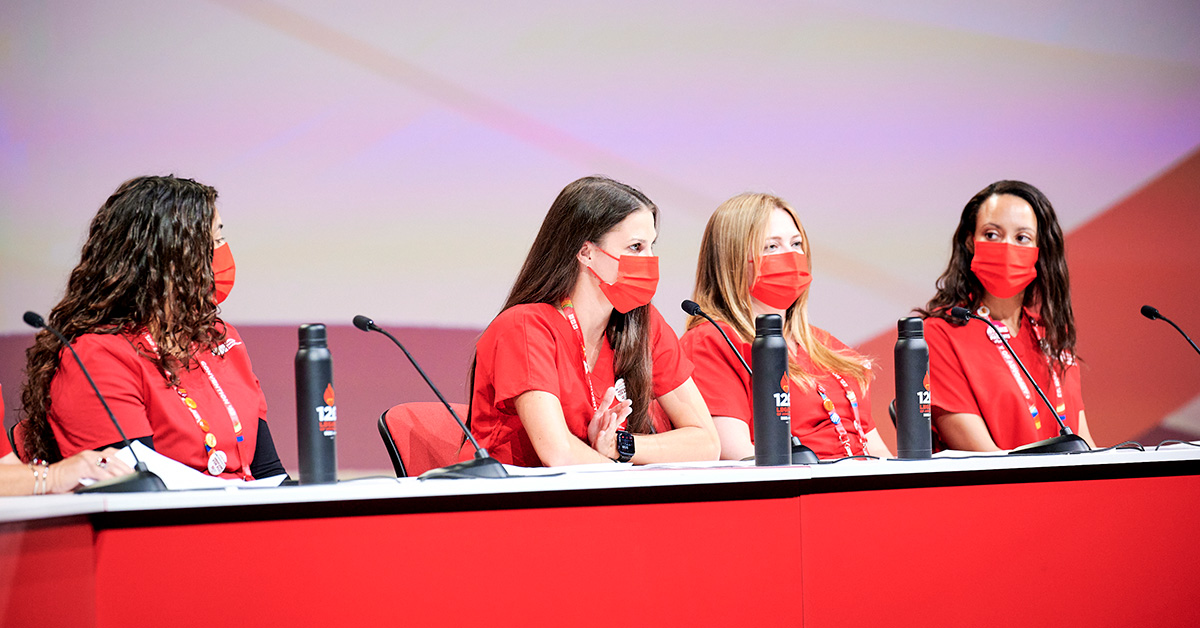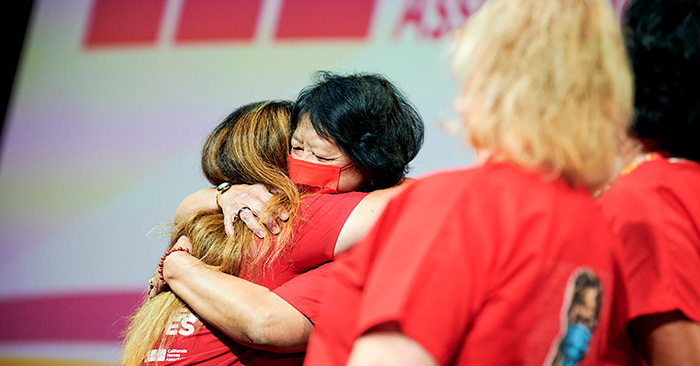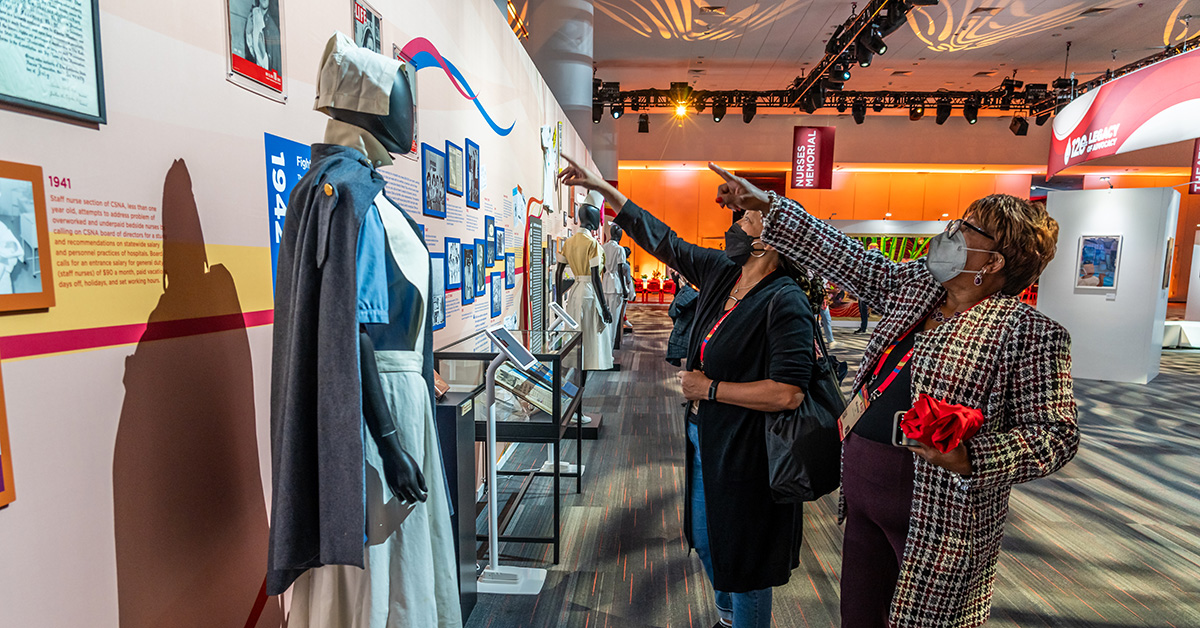Unconventional Times

CNA/NNOC celebrated 120 years of advocacy and laid groundwork for decades more
By Michelle Morris
National Nurse magazine - Oct | Nov | Dec 2023 Issue
“There was not a dry eye in the audience,” said Hannah Drummond, an Asheville, N.C. RN and California Nurses Association/National Nurses Organizing Committee (CNA/NNOC) member, reflecting about her experience watching The People Speak, the capping performance of the CNA/NNOC 2023 convention this fall.
Nurses gathered to watch actors and musicians bring to life the inspirational words of rebels, dissenters, organizers, and visionaries who built, and are building, the movements for progressive social change in this country.
In a fitting finale, nurses heard the powerful words of Minnesota nurse Emily Pierskalla. In a blazing testimony, recorded on her camera phone in the early months of Covid-19 and shared with the world on social media, she challenged the inaction of our so-called leaders and called on the public to politicize her death: “Use my death to mobilize others. Use my name at the bargaining table. Use my name to shame those who have profited or failed to act, leaving us to clean up the mess.”
It was Drummond’s first union convention, and she reflected: “It was a powerful reminder that union nurses are advancing society. And it’s our stories that are the key to our success as union nurses. It’s about owning our power by owning our narrative. By telling the real story of what is happening, we can move more people, from politicians to our patients and community members to other nurses, to join our fight.”
The People Speak ended a powerful two days of learning, sharing, inspiration, and solidarity. The 2023 convention, titled “Legacy of Advocacy,” marked both the first time members had gathered in person since the pandemic and also the 120th anniversary of the union’s founding. The power of remembering and the power of telling our stories were themes woven throughout the convention, starting with executive director RN Bonnie Castillo’s opening remarks.
In her speech, she implored the 3,000 nurses in the audience to be “historians of this moment” amidst powerful institutions, governments, and corporations denying and disregarding reality so they can enforce and entrench the forces of capitalism, racism, sexism, violence, and fascism.
Telling our stories is both a refusal to “let our employers or our elected officials pass off their lies to future generations” and how nurses remain “the keepers of the right side of history,” she encouraged.
The stories shared by nurses during the convention showed that not only is our union on the right side of history – we are winning. On the second day, Drummond and other emerging leaders in our union took the stage. All represented the promise and the necessity of militant organizing, discussing how they organized their facilities during the pandemic, despite facing hostile “right-to-work” laws, well-resourced employers, and union-busting consultants.
Like Drummond, this was RN Kristine Kittelson’s first time at a CNA/NNOC convention. Kittelson, who’s currently helping bargain the union’s first contract at Ascension Seton Medical Center in Austin, Texas, took the stage with Drummond to discuss the power she felt joining the union and becoming a leader.
“Going to this convention was a powerful reminder of what our movement of union nurses is fighting for – not just in our country, but all around the world,” Kittelson reflected a couple of weeks after the convention, referencing the group of approximately 200 nurses who arrived from countries as far away as New Zealand and India, as part of the Global Nurses United meeting. “It’s not just about changing the culture of our individual facilities, but also changing the profession as a whole.”

For anyone at the convention not yet acquainted with CNA/NNOC’s principled commitment to taking back the nursing profession from managers and executives, they got a taste of it when outgoing CNA/NNOC President Zenei Triunfo-Cortez and incoming president Michelle Gutierrez Vo took the microphone one morning. Their stories of fighting back – and winning – against Kaiser Permanente emphasized the flawed promises of labor-management partnerships.
Triunfo-Cortez recounted how she and other CNA members mounted an epic campaign against the health care giant when it announced it would close its Oakland campus in 1996. This was unacceptable to RNs. Because Oakland is a very racially diverse, working-class city with relatively high health needs, Triunfo-Cortez explained, the hospital’s closure would harm the community.
In an epic fight, she described how – with patients, hospital staff, church groups, and patients – nurses held rallies, hosted town halls, and attended council meetings, escalating their campaign over the course of two years. Then CNA filed a lawsuit against Kaiser alleging medical redlining, backed up by the facts collected through extensive research and patient testimonies. It was this incredible pressure that finally resulted in Kaiser announcing it would keep the hospital open.
More than two decades later, following a catastrophic pandemic that revealed how little Kaiser cared for its nurses and health care workers, 22,000 CNA nurses won a historic contract. Gutierrez Vo explained it took an entire year of preparation, of intense organizing, and of strategic escalation.
“By the time we issued a 10-day notice to strike with 22,000 nurses, Kaiser management was terrified,” Gutierrez Vo explained, and of course, a few days before the strike was set to begin, Kaiser caved and nurses won.
Their stories of challenging Kaiser Permanente – eschewing other unions’ model of compromise with hospital employers – underscore the power of nurses embracing militancy instead.
These victories, even though more than two decades apart, had an important thing in common: a refusal to let hospitals abandon our communities and degrade care to make money.
As Triunfo-Cortez reflected, “In these fights, we reinforced our partnership with our patients, our communities, and the public. And this wisdom enabled us to take a historic stance against the idea of labor-management partnerships in the face of contract takeaways.”
It’s this wisdom that has allowed the union to grow in numbers and in strength, to win battles at the facility level, in the halls of government, and beyond. Stories like Marlene Tucay’s, an RN at the University of California Irvine Medical Center (UCIMC), poignantly captured the benefits of being a union nurse: in addition to improving the longevity and sustainability of a nursing career, it gives members tools and resources to make the world a better place for all of us.
Tucay described how she and other nurses at UCIMC rallied together in support and defense of one of their transgender union sisters who was a target of discrimination by management. On stage, she shared the letter of gratitude her colleague sent after nurses worked to ensure that justice prevailed and this manager was fired. The 3,000 CNA/NNOC nurses in the room stood up in a standing ovation. The emotion was raw and it was palpable.
Helena Johnson, an RN at HCA Osceola in Kissimmee, Fla., thought that was a powerful lesson for members to take away: “It was great to hear stories of nurses sticking with each other and sticking up for each other. It’s important to me, as a Black woman, as an immigrant, as a mom, and a Catholic to stand up to disrespect when I see it. A work environment should always be safe.”
In that session, Tucay and other nurse leaders on stage, like Triunfo-Cortez and Marissa Lee, an RN and CNA/NNOC board member at HCA Florida Osceola Hospital shared the pain of being questioned and targeted simply because of their identities as women of color and as immigrant women. They also shared the empowerment they felt when they stood up – with their union behind them – to the forces of racism and sexism.
That’s a lesson Johnson wants to take back to her hospital: “I want people to understand that we are the union.”
Over the course of the convention, nurses were equipped with the education, resources, and empowerment to advance their campaigns and boost their own leadership skills. While the mornings were spent in “plenary sessions” hearing from panels of nurses on issues such as bargaining and organizing, the afternoons gave nurses the chance to take continuing education (CE) courses on a variety of topics affecting the nursing profession.
Stephanie Moraes, an RN and bargaining team member at Adventist Health in Lodi, Calif., said of her first convention and the CE courses she attended: “Learning about the hospital industry’s business models really opened my eyes. I’m a new nurse and a new union nurse, so I am learning just how much hospitals, including the ones who describe themselves as ‘nonprofit’ and ‘for the people,’ do everything simply to maximize their profits. It really lit a fire in me that we’re not going to be taken advantage of.”
Away from the bustle of the convention’s main activities, the Memorial Garden and the CNA/NNOC timeline exhibit emphasized the power of remembering our history and telling our stories.
In a space created for reflection and quiet, CNA/NNOC nurses had the chance to sit among trees and a reflecting pool. The names of nurses who passed away from Covid-19 were hung up on the branches of the trees, while a screen projected additional names of those we lost. Nurses also had the chance to add their own names of those who died from Covid-19 and messages of love, gratitude, and grief.
Johnson, who went to the Memorial Garden at least three times during the convention, experienced powerful emotions when she sat in the space: “Oh my god, I’m getting chills just thinking about it. I sat down on the benches, looked at all the names and faces, and realized I was crying. It was a beautiful tribute that gave you the time to reflect. I didn’t realize so many nurses had died.”
Echoing the message of Castillo in her opening remarks for the convention, Johnson said, “We have to tell the truth about what happened. We can’t allow the lies to take over our loss.”

A short walk from the Memorial Garden, nurses had the chance to look at the timeline of our union’s 120-year history. In addition to written descriptions of major events in the last 12 decades of our union’s history, there were photos, protest placards, nursing uniforms and t-shirts, pamphlets, and other souvenirs that brought to life the vibrant and rich legacy to which CNA/NNOC nurses belong.
In between the quiet reflection and the learning, there was also space for catharsis, joy, and empowerment.
“When people asked me about my convention experience, I told them that it was the full spectrum of feelings,” Drummond shared. “We got to grieve our difficulties. We had space to learn from each other and help each other. We celebrated too! After three years of working really hard to find joy, getting to vibe out on the dance floor, make friends, and just so easily enjoy ourselves, it was amazing.”
Kittelson agreed: “It was really inspiring to learn about changes I can fight for in my facility, that I hadn’t even imagined possible. The world really is our oyster.”
“I left feeling more courageous after hearing other people’s stories of collective action,” reflected Moraes. “The next week, we did a march on the boss and delivered a box of ADOs. That courage came from attending convention.”
Michelle Morris is a communications specialist at National Nurses United.